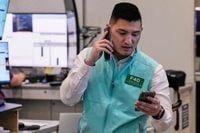Stocks on Wall Street took a step back on Monday, August 18, 2025, as investors digested last week’s robust rally and weighed the odds of an upcoming interest rate cut from the Federal Reserve. The day’s declines were broad-based, cutting across sectors and reflecting a market that’s both hopeful and hesitant as it eyes the next moves from America’s central bank.
The S&P 500, which had flirted with all-time highs just days earlier, slipped 0.4% to close at 6,439.32, according to data reported by the Associated Press and Barchart.com. The Dow Jones Industrial Average, fresh off a record close on Friday, lost 349.27 points, or 0.8%, ending the session at 45,282.47. The tech-heavy Nasdaq Composite also retreated, dropping 0.2% to 21,449.29, while the Nasdaq 100 Index dipped 0.31% to 23,425.60.
It wasn’t a dramatic sell-off, but the mood was noticeably more cautious after last week’s optimism. Health care stocks led the day’s laggards, with Pfizer tumbling 2.9% to $25.14 and Eli Lilly and Co. down 2.3%. Intel fell 1.01% to $24.55, and Best Buy slipped 1.42% to $74.32. The pain was even more acute for Keurig Dr Pepper, which sank a staggering 11.5% to $31.10 after announcing it would acquire Peet’s Coffee owner JDE Peet’s in an $18 billion deal.
Railroad stocks also lost steam following news that Warren Buffett, the legendary investor, had informed CSX management he wasn’t interested in buying the railroad. CSX shares dropped 5.1%, Union Pacific fell 1.99% to $223.32, and Norfolk Southern gave up 2.53% to $277.39. The sector’s decline underscored just how quickly sentiment can shift on Wall Street when big names change their tune.
Yet, amid the gloom, a few bright spots shone through. Technology giants Alphabet (Google’s parent company) and Nvidia managed to buck the broader trend, rising 1.16% to $208.49 and 1.02% to $179.81, respectively. These gains helped temper some of the day’s losses and highlighted the continued influence of tech heavyweights on the overall market. As Anthony Saglimbene, chief market strategist at Ameriprise, told the Associated Press, “Markets are just digesting Friday’s news and kind of the increasing odds that we’re going to see a September rate cut from the Fed.”
The bond market also reflected shifting expectations. The yield on the 10-year Treasury note rose to 4.28% from 4.25% late Friday, while the two-year Treasury yield climbed to 3.73% from 3.70%. Rising yields typically signal that investors are adjusting their bets on future interest rates, and right now, those bets are heavily tilted toward a rate cut in September. According to CME Group data, traders see an 84% chance that the Federal Reserve will trim its benchmark rate by a quarter of a percentage point at its next meeting.
That’s a significant shift in sentiment, given that the Fed has kept rates steady since the end of 2024 amid persistent worries about inflation. The central bank’s dual mandate—keeping inflation low while supporting strong employment—has been put to the test in recent months. While inflation remains a concern, with tariffs working their way through the economy and pushing up some prices, recent signals suggest the U.S. job market may be stagnating or even weakening. That, in turn, could give the Fed the nudge it needs to cut rates and provide a little more juice to the economy.
But there’s a delicate balance at play. Lower interest rates make borrowing cheaper, which can spur investment and consumer spending—good news for businesses and workers alike. The flip side, of course, is that easier money can also fuel inflation, which remains stubbornly above the Fed’s preferred 2% target. According to the Associated Press, economists expect Friday’s upcoming report on the personal consumption expenditures (PCE) price index to show that prices rose 2.6% in July compared to a year ago, unchanged from June and still hovering just above the central bank’s comfort zone.
Consumer confidence, meanwhile, is expected to remain mostly unchanged in August compared to July, with The Conference Board set to release its monthly survey on Tuesday. While confidence hasn’t cratered, concerns about inflation continue to simmer under the surface. Retailers, in particular, are under the microscope as Wall Street tries to gauge the impact of tariffs on costs and prices. Best Buy and Dollar General are both slated to report earnings on Thursday, offering another window into how consumers are faring in the current environment.
Technology stocks, especially those connected to artificial intelligence, remain a focal point for investors. Nvidia, which has become a bellwether for the broader market thanks to its role as a key supplier of AI chips, is scheduled to report its latest results on Wednesday. As Saglimbene noted, “There’s more doubt around the AI theme building. So I think what Nvidia has to say is going to be very impactful for not only the whole AI space, but the broader markets in general, because it’s such a large holding in the major indexes like the S&P 500 and Nasdaq.”
Elsewhere, global markets echoed Wall Street’s cautious tone. European stocks mostly closed lower, following on the heels of declines in Asian markets overnight. Investors worldwide are grappling with many of the same concerns: inflation, central bank policy, and the durability of the current economic expansion.
All told, Monday’s pullback wasn’t a panic—it was more of a pause. After a week of strong gains, a little profit-taking is hardly surprising, especially with so many key data points and earnings reports on the horizon. As the market awaits fresh clues from the Fed, economic data, and corporate America, the mood is one of cautious optimism. Everyone’s watching to see whether the rally can resume—or if more bumps lie ahead.
With so much riding on interest rates, inflation, and consumer sentiment, investors will be glued to the next round of updates. For now, Wall Street is taking a breather, but the story is far from over.



